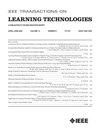Improving Ray Tracing Understanding With Immersive Environments
IF 4.9
3区 教育学
Q2 COMPUTER SCIENCE, INTERDISCIPLINARY APPLICATIONS
引用次数: 0
Abstract
Ray tracing is a computer graphics technique used to produce realistic visuals by physically simulating the behavior of light. Although this technique can be described straightforwardly, fully comprehending it might be challenging. It is typically taught in the classroom using the 2-D formats, such as paper or a blackboard. We propose using immersive environments for incrementing the understanding of ray tracing. We focus on improving the knowledge of the technique in experienced users, particularly Master of Computer Science students minoring in a computer-graphics-related area. We argue that exploring the ray tracing process in an immersive visualization environment can further improve the understanding of ray tracing acquired using conventional means. With that objective, this study starts by presenting利用沉浸式环境提高光线跟踪理解能力
光线跟踪是一种计算机图形技术,用于通过物理模拟光线的行为来产生逼真的视觉效果。虽然这种技术可以简单明了地描述,但要完全理解它可能会很困难。课堂教学中通常使用二维格式,如纸张或黑板。我们建议使用沉浸式环境来加深对光线追踪的理解。我们的重点是提高经验丰富的用户,尤其是计算机科学硕士学生对计算机图形学相关领域的了解。我们认为,在身临其境的可视化环境中探索光线跟踪过程,可以进一步提高使用传统方法获得的对光线跟踪的理解。为此,本研究首先介绍了 RayTracerVR,这是一种用于学习光线追踪机制的虚拟现实原型工具。该工具可用于对光线追踪技术的不同方面进行可视化探索和互动。用户可以在光线追踪过程的各个阶段观察光线的进展,并分析相应的计算机伪代码。研究包括用户评估,通过使用 RayTracerVR 来评估光线追踪理解能力的提高情况。此外,还对原型的可用性进行了评估。研究结果表明,使用光线追踪沉浸式学习环境可以补充提高以前使用传统方法学习光线追踪的用户的理解能力。
本文章由计算机程序翻译,如有差异,请以英文原文为准。
求助全文
约1分钟内获得全文
求助全文
来源期刊

IEEE Transactions on Learning Technologies
COMPUTER SCIENCE, INTERDISCIPLINARY APPLICATIONS-
CiteScore
7.50
自引率
5.40%
发文量
82
审稿时长
>12 weeks
期刊介绍:
The IEEE Transactions on Learning Technologies covers all advances in learning technologies and their applications, including but not limited to the following topics: innovative online learning systems; intelligent tutors; educational games; simulation systems for education and training; collaborative learning tools; learning with mobile devices; wearable devices and interfaces for learning; personalized and adaptive learning systems; tools for formative and summative assessment; tools for learning analytics and educational data mining; ontologies for learning systems; standards and web services that support learning; authoring tools for learning materials; computer support for peer tutoring; learning via computer-mediated inquiry, field, and lab work; social learning techniques; social networks and infrastructures for learning and knowledge sharing; and creation and management of learning objects.
 求助内容:
求助内容: 应助结果提醒方式:
应助结果提醒方式:


